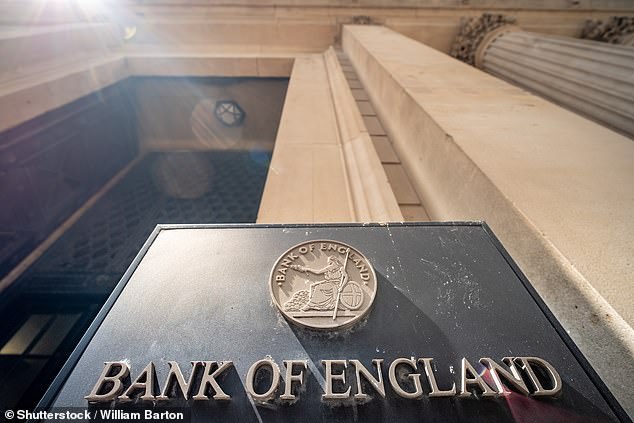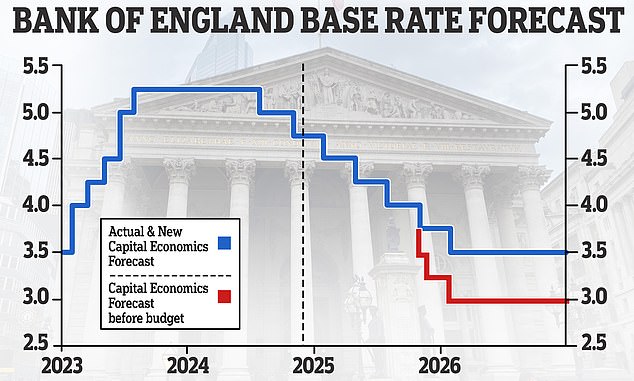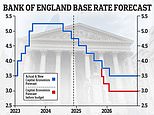The Bank of England cut interest rates on 6 February from 4.75 per cent to 4.5 per cent.
The decision came as little surprise to financial markets, with the 0.25 basis point cut widely predicted by analysts.
Interestingly, while the Monetary Policy Committee voted by a majority 7–2 to reduce base rate to 4.5 per cent, those two members opted for a deeper 0.5 percentage point cut to 4.25 per cent.
It represented the first time the base rate has been at 4.5 per cent for more than 18 months. The next decision is on 20 March.
Future base rate decisions are likely to hinge not just on the rate of inflation, but also on the health over the overall economy.
The ONS revealed that inflation rose 2.5 per cent in the 12 months to December – slightly below what markets forecast.
However, the Bank of England is forecasting that inflation is likely to rise to 3.7 per cent over the first half of this year.
This will largely be due to increases in energy prices, and increases in some regulated prices such as water bills.
The central bank says inflation is expected to fall back to the 2 per cent target after that.

What next for interest rates?
At present, markets are pricing in two further interest rate cuts between now and the end of this year. This could see the base rate will fall to 4 per cent by the end of 2025.
However, as is to be be expected, forecasts vary.
Santander expects interest rates to fall to 3.75 per cent by the end of 2025 while Barclays is a bit more punchy thinking rates will fall as far 3.5 per cent.
Analysts at Morgan Stanley predict UK interest rates will fall to 3.5 per cent by the end of this year, while Goldman Sachs says interest rates will fall to 3.25 per cent by June next year.
The two giant US banks believe the UK economy will struggle over 2025 forcing the Bank of England to take action and cut rates more aggressively.
Both banks say lower GDP growth will be exacerbated by a slowdown in household disposable incomes. Goldman Sachs sees further pressure coming from rising trade tensions.
As a result, both expect growth of only 0.9 per cent in 2025 – below the Bank of England’s 1.5 per cent and the OBR’s 2 per cent forecasts, as well as the market consensus of 1.3 per cent.
Meanwhile, economists at Capital Economics think the base rate will fall to 3.5 per cent by early 2026.
They had previously forecast that interest rates would fall to 3 per cent by the end of next year, but have concluded that rates will now fall slower as a result of the Labour’s first budget.
Looking even further ahead than late 2025 and early 2026, economists vary on where they think interest rates will level off.
Santander, for example, thinks interest rates will remain between 3 per cent and 4 per cent for the foreseeable future.
However, economists at Oxford Economics are predicitng base rate will eventually fall to 2.5 per cent in 2027 where it will broadly remain throughout 2028 and 2029.

The base rate and the Bank of England
The Bank of England moves what is officially known as bank rate but more commonly called base rate to try to control inflation.
Base rate is the single most important interest rate in the UK. It determines the interest rate the Bank of England pays to commercial banks that hold money with it and therefore influences the rates those banks charge people to borrow money or pay on their savings.
The theory is that raising interest rates lifts the cost of borrowing for individuals and businesses and thus reduces demand for it, slowing the flow of new money into the economy and applying the brakes.
In contrast, cutting interest rates lowers the cost of mortgage rates and other borrowing and increases demand, pushing the accelerator on the economy.
Higher savings rates also make saving more attractive, while lower rates encourage spending over setting money aside.
The MPC sets interest rates to try to keep consumer prices inflation (CPI) at the Bank and Government’s 2 per cent target.
> Interest rate rise and fall calculator: How moves affect your payments
What’s happened to inflation and interest rates
A major inflation spike over recent years saw CPI rocket into double-digit territory, driven by the aftermath of the disruptive Covid lockdowns combined with an energy price crisis triggered by Russia’s invasion of Ukraine.
This saw the Bank of England raise base rate rapidly from its record low of 0.1 per cent, reached during the Covid pandemic years.
The first move up to 0.25 per cent came in December 2021 and a sharp series of rises from the MPC followed, driving base rate all the way up to 5.25 per cent in August 2023.
Rates were then held at 5.25 per cent until August 2024, when they were cut to 5 per cent. The next cut was to 4.75 per cent in November 2024 and then to 4.5 per cent in February,

Watch the Fed on US interest rates
UK base rate moves have tended to follow a similar route as the Federal Reserve in the US and are also influenced by other major central banks.
It makes sense to be moving in a similar direction to other central banks, such as the Fed and the European Central Bank (ECB) to limit fluctuations in the pound, which can cause inflation to rise or fall..
The ECB cut interest rates four times last year with the key rate now at 3.15 per cent, down from a high of 4.5 per cent.
A bumper 0.5 percentage point Fed rate cut arrived in September, along with doveish comments from Fed chair Jerome Powell on rates continuing to fall.
The fed followed this up in early November by reducing its policy rate by a further 0.25 percentgage points before announcing another cut in December leaving the funds rate at 4.5 per cent.

What base rate means for savings and mortgage rates?
Many people assume that savings rates and mortgage rates are directly linked to the Bank of England base rate.
In reality, future market expectations for interest rates and banks’ funding and lending targets and appetite for business are what really matters.
Market interest rate expectations are reflected in swap rates. A swap is essentially an agreement in which two banks agree to exchange a stream of future fixed interest payments for another stream of variable ones, based on a set price.
These swap rates are influenced by long-term market projections for the Bank of England base rate, as well as the wider economy, internal bank targets and competitor pricing.
In aggregate, swap rates create something of a benchmark that can be looked to as a measure of where the market thinks interest rates will go.
Current swap rates suggest that mortgage rates won’t fall much further over the coming years, but not dramatically so.
As of 4 February, five-year swaps were at 3.87 per cent and two-year swaps at 4.22 per cent – both trending below the current base rate.
Any borrowers hoping for a return to the rock bottom interest rates of 2021 will likely be disappointed. On the flipside, savers will be reassured that rates are not expected to plummet to the depths again.
It’s worth pointing out that while swap rates are a good metric for where markets think interest rates are going, they also change rapidly in response to economic changes.
Richard Carter of Quilter Cheviot adds: ‘Swap rates are a useful indicator of current expectations, but it is important to remember they are no better at predicting the future than any other economic indicator. The economic outlook can change very quickly and very dramatically.’
> Saving and banking: Read the latest on savings rates and top deals

What should savers do?
Experts foresee savings rates falling now that the Bank of England has cut the base rate.
Savers can still get around 4.5 per cent in a standard easy-access savings account or as high as 5 per cent with an easy-access cash Isa, and the best fixed rate savings offer around to 4.75 per cent.
Rachel Springall, finance expert at Moneyfacts said: ‘Savers are the ones who feel the force of cuts to interest rates, and to add insult to injury, will see no rise to any personal tax or savings allowances in the short-term, making cash Isas increasingly attractive.
‘Those savers who use their interest to supplement their income will feel overlooked if rates plummet.
‘In December 2021, the average easy access rate stood at a pitiful 0.2 per cent and it took months for this to rise above a measly 1 per cent – even though the Bank of England base rate had risen from 0.1 per cent to 2.25 per cent over that time.
‘Safe to say, it’s understandable that savers feel hard done by, barely seeing a return on their money and in fact, watching the true value of their cash eroded by unprecedented high inflation.
‘This could in turn, create an almost apathetic attitude among savers today, even as the average easy access account pays around 3 per cent, bank base rate is higher.
‘Shockingly, there are UK current or savings accounts out there earning no interest whatsoever, £252bn worth in fact, according to the Bank of England.’
The good news is that with inflation at 2.5 per cent, it means savers who hold their cash in the top paying accounts will still be making a real return, albeit before tax.
Our savings tables show the best easy-access savings, top cash Isas and fixed rate savings deals.
The advice to savers has been to keep on top of the changing market if they want to secure a competitive deal.
Springall adds: ‘Challenger banks are offering attractive returns and it would be unwise to overlook them when they have the same protections in place as a high street bank.
‘Savers need to proactively keep on top of the best rates and review their pots regularly to see if they are getting a raw deal.’
> Sign up to our savings alerts and be the first to find out about top deals
What next for mortgage rates?
Between the start of July and early October last year, the cheapest available five-year fixed rate mortgage fell from 4.28 per cent to 3.68 per cent.
Meanwhile, the lowest two-year fix fell from 4.68 per cent to 3.84 per cent during that time.
But they have crept back up again with the lowest five-year fix at 4.13 per cent and the lowest two-year fix at 4.23 per cent.
Mortgage borrowers on fixed term deals should look to where markets are forecasting the base rate to go in future and how this ties in with when their fixed rate ends.
But they should also be aware that mortgage rates can be volatile and a flurry of rises or cuts can soon be reversed.
Banks tend to pre-empt base rate moves. They change their fixed mortgage rates on the back of predictions about when base rate will fall or how high it will go, and how long inflation will remain high.
Banks and building societies general view on the housing market and economy also affect their appetite to lend, which feeds through into whether they want to cut or raise rates on offer to increase or dampen demand.
Sonia swap rates, which reflect lenders’ expectations of future interest rates and play a critical role in how fixed-rate mortgages are priced.
Over the past two weeks, some major lenders have lowered fixed mortgage rates.

Halifax, HSBC and Clydesdale Bank cut mortgage rates following on from similar fixed rate cuts by Barclays and Coventry Building Society.
Will borrowers benefit from future base rate cuts?
Future base rate cuts are already largely baked into fixed rate mortgage pricing and means most borrowers won’t notice much difference when it comes to their mortgage rates – even with further base rate cuts down the line.
The bulk of outstanding residential mortgages are fixed rate and for the vast majority of these people, the base rate change won’t have any immediate impact anyway until their fixed term ends.
Robert Gardner, chief economist at Nationwide, said: ‘Investors expect bank rate to be lowered modestly in the years ahead, which, if correct, will help to bring down borrowing costs.
‘However, the impact is likely to be fairly modest as the swap rates which underpin fixed-rate mortgage pricing already embody expectations that interest rates will decline in the years ahead.’
The mortgage borrowers who stand to benefit the most are those on tracker and variable rates.
Variable rate mortgages include ‘discount’ rates and also standard variable rates (SVRs). Monthly payments on all these types of loan can go up or down.
Tracker rates follow the Bank of England’s base rate plus a set percentage, for example base rate plus 0.75 per cent. They often come without early repayment charges, allowing people to switch whenever they like without incurring a penalty.
Standard variable rates are lenders’ default rates that people tend to move on to if their fixed or other deal period ends and they do not remortgage on to a new deal.
These can be changed by lenders at any time, and will usually rise and fall when the base rate does – but they can go up or down by more or less than the Bank of England’s move.
According to Moneyfacts, the average SVR is just shy of 8 per cent, which is a lot higher than the average of 4.4 per cent in December 2021 when base rate was just 0.1 per cent – but it will vary from lender to lender.


